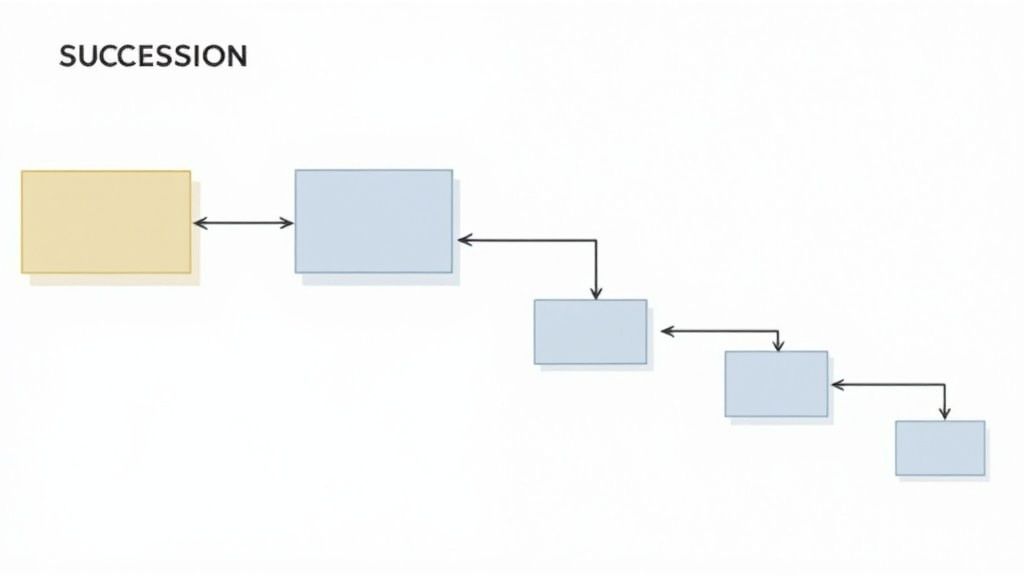Leadership and key role transitions are inevitable, but operational chaos doesn’t have to be. Effective succession planning is no longer a passive, once-a-decade activity for the C-suite; it’s a dynamic, continuous strategy essential for organizational resilience and sustained growth. A sudden departure without a clear plan can disrupt projects, create knowledge vacuums, and damage team morale, halting momentum and costing valuable time.
This guide moves beyond generic advice to provide a concrete framework of actionable succession planning best practices. We will delve into eight critical strategies designed for modern teams, covering everything from identifying high-potential talent early to implementing robust knowledge transfer programs. You will learn not just what to do, but how to do it effectively within your existing workflows.
Crucially, we’ll explore how modern tools like Jira, when enhanced with automation apps such as Out of Office Assistant, can transform theoretical plans into seamless, automated handovers. This approach ensures that critical tasks, tickets, and approvals never stall, even during unexpected absences or planned transitions. By implementing these practices, you can build a future-proof organization where leadership changes become a managed process for growth, not a sudden source of disruption. Get ready to turn a potential crisis into a well-orchestrated, low-impact event that keeps your business moving forward without interruption.
1. Start Early and Plan Continuously
The most effective succession planning best practices are proactive, not reactive. Treating succession planning as a continuous, strategic process rather than a one-time emergency drill is fundamental to organizational stability and growth. This approach involves identifying and nurturing talent for critical roles years before a transition is expected, embedding leadership development deep within the company’s operational rhythm.

When succession planning is an ongoing activity, it becomes part of the culture. This mindset shifts the focus from merely filling a vacant high-level position to building a robust pipeline of leaders at every level. It ensures that when a key team member departs, whether planned or unexpected, a well-prepared successor is ready to step in, preventing operational disruptions and maintaining momentum.
Why It’s a Top Practice
Delaying succession planning until a leader announces their departure creates a high-pressure, high-risk situation. Organizations are forced to make rushed decisions, often leading to poor choices or expensive external hires who may not align with the company culture. A continuous process mitigates these risks entirely.
Key Insight: A continuous planning model transforms succession from a crisis management task into a strategic advantage, ensuring leadership continuity is a predictable outcome, not a fortunate accident.
Actionable Implementation Steps
To integrate this practice into your organization, consider the following structured approach:
- Integrate with Strategic Planning: Make succession discussions a mandatory component of your annual strategic planning sessions. Align leadership development goals with long-term business objectives.
- Establish a Long-Term Horizon: Begin identifying and developing potential successors for critical roles at least 3 to 5 years before an anticipated transition, such as a retirement. For deeper cultural integration, like Procter & Gamble’s model, development tracks can span decades.
- Create Formal Development Timelines: Don’t leave growth to chance. Map out specific milestones for potential successors, including mentorship programs, targeted training, cross-functional project assignments, and leadership coaching.
- Regularly Review and Adapt: The business landscape changes, and so do people’s career aspirations. Review your succession plans quarterly or bi-annually to ensure they remain relevant and aligned with current organizational needs and individual performance.
2. Identify and Develop High-Potential Talent
A cornerstone of succession planning best practices is the systematic identification and targeted development of high-potential employees. This practice moves beyond evaluating current job performance to assess an individual’s future leadership capabilities, focusing on qualities like cognitive agility, emotional intelligence, strategic thinking, and cultural alignment. It’s about spotting the seeds of future leadership and creating the ideal conditions for them to grow.

This methodical approach ensures that your leadership pipeline isn’t left to chance. By proactively investing in these “Hi-Pos,” organizations like Unilever with its Future Leaders Programme and Johnson & Johnson with its cross-business unit leadership programs build a versatile and loyal group of future leaders. This internal talent pool becomes a powerful asset, ready to fill critical roles with individuals who already understand the company’s vision and values.
Why It’s a Top Practice
Relying solely on external hires for senior roles is expensive, time-consuming, and culturally risky. Developing talent internally fosters loyalty, boosts employee morale, and ensures that future leaders have a deep, nuanced understanding of the business. It creates a culture of growth where employees see a clear path for advancement, motivating them to invest their careers in your organization.
Key Insight: True succession planning isn’t just about filling a vacant chair; it’s about cultivating a garden of talent so that when a position opens, you have multiple well-nurtured, ready-to-bloom candidates to choose from.
Actionable Implementation Steps
To effectively identify and nurture your high-potential talent, implement these structured actions:
- Use Multiple Assessment Methods: Avoid a single point of view. Combine performance reviews with 360-degree feedback, psychometric assessments, and simulations to get a holistic view of an employee’s potential.
- Provide Diverse Developmental Experiences: Move beyond classroom training. Assign potential leaders to cross-functional projects, offer stretch assignments in different departments, and provide international or high-stakes opportunities to build their resilience and strategic perspective.
- Create Individual Development Plans (IDPs): Work collaboratively with each high-potential employee to create a personalized growth roadmap. A crucial aspect of this involves creating robust career development paths. For more insights, consult a detailed career development guide to help build your strategy.
- Calibrate Talent Reviews Regularly: To mitigate bias and ensure fairness, hold regular calibration sessions where managers discuss and defend their high-potential nominations. This process, championed by research from firms like Korn Ferry, ensures a consistent and objective standard across the organization.
3. Create Detailed Succession Plans for Key Positions
Once you’ve identified your critical roles, the next step in effective succession planning is to create comprehensive, documented plans for each one. These are not just names on a list; they are living documents that outline potential successors, their readiness levels, specific development needs, and clear transition timelines. This approach ensures you are prepared for both immediate emergencies and planned long-term handovers.

A detailed plan acts as a strategic roadmap for leadership continuity. It moves beyond abstract ideas by specifying the skills, experiences, and training a candidate needs to successfully fill a key position. For instance, 3M’s systematic approach ensures that for every major business division, there is a clear and well-vetted succession pathway, preventing leadership gaps and maintaining operational excellence.
Why It’s a Top Practice
Without a detailed plan, succession efforts are often reduced to guesswork during a crisis. A documented plan provides clarity, objectivity, and a structured framework for making one of the most important decisions a company can face: choosing its next leader. This formalized process, championed by experts like Ram Charan, helps remove bias and ensures decisions are based on data and strategic fit, not just familiarity or tenure. It forces the organization to think critically about future needs, not just current capabilities.
Key Insight: A detailed succession plan transforms an abstract concept into an actionable strategy, providing a clear blueprint for developing future leaders and ensuring seamless transitions when they matter most.
Actionable Implementation Steps
To build robust succession plans for your most critical roles, follow this structured method:
- Identify Multiple Successors: For each key position, aim to identify 2-3 potential successors. This creates a healthy pipeline and provides options if a primary candidate leaves the company or proves unsuitable.
- Categorize by Readiness: Classify candidates into clear readiness levels: Ready Now (can step in immediately), Ready Soon (within 1-2 years), and Ready Later (3-5 years). This helps prioritize development efforts.
- Create Individual Development Plans (IDPs): For each identified successor, document specific gaps in skills or experience. Create a tailored IDP that includes stretch assignments, mentorship, formal training, and coaching to close those gaps. A well-structured plan is crucial for this step; you can find more guidance on how to create one in this detailed transition plan example on resolution.de.
- Annual Review and Refresh: Succession plans are not static. Review and update them at least annually, or more frequently if significant organizational changes occur. This ensures the plans remain aligned with business strategy and reflect the current performance and aspirations of potential successors.
4. Implement Cross-Training and Knowledge Transfer Programs
A leader’s departure often means the loss of invaluable institutional knowledge, critical skills, and key relationships. One of the most critical succession planning best practices is to systematically capture and transfer this expertise before it walks out the door. This involves creating formal programs for knowledge documentation, cross-training, and mentorship to ensure a seamless transition and minimize operational risk.

This practice moves beyond simple handovers, establishing a structured framework where tacit knowledge, the kind not easily written down, is shared through direct interaction and observation. For example, Chevron’s systematic approach to transferring deep technical knowledge from its retiring engineers to the next generation ensures that decades of project experience are retained within the company, preventing costly mistakes and accelerating the development of future leaders.
Why It’s a Top Practice
Without a formal knowledge transfer process, organizations risk creating a significant capabilities gap when a key leader leaves. Successors are left to reinvent the wheel, struggling to understand complex processes, historical context, and critical stakeholder relationships. This not only slows down their integration but can also lead to a decline in team performance and project momentum.
Key Insight: Proactive knowledge transfer turns a high-risk transition into a structured learning opportunity, equipping successors with the deep institutional wisdom they need to succeed from day one.
Actionable Implementation Steps
To build a robust knowledge transfer framework, follow these structured steps:
- Create Structured Knowledge Transfer Templates: Develop standardized documents and checklists that outgoing leaders must complete. These should cover key responsibilities, project histories, stakeholder maps, and undocumented processes or “tribal knowledge.”
- Allocate Dedicated Time for Sharing: Make knowledge transfer a formal part of the job, not an afterthought. Schedule regular sessions for job shadowing, mentoring, and collaborative problem-solving between the incumbent and the potential successor.
- Use Multiple Transfer Methods: Combine different approaches for maximum effectiveness. Use formal documentation for processes, job shadowing for observing leadership in action, and mentorship for transferring strategic insights and navigating organizational culture.
- Establish a Clear Timeline: Define a clear timeline with specific milestones for the knowledge transfer process, starting well before the planned departure. This ensures all critical areas are covered without a last-minute rush. To further support this, you can learn more about how to effectively cross-train your employees.
5. Establish Clear Communication and Transparency
A successful succession plan cannot exist in a vacuum. One of the most critical succession planning best practices is to foster an environment of open, honest communication about the process, criteria, and decisions involved. While balancing transparency with necessary confidentiality, this practice ensures that stakeholders, from the board down to emerging leaders, understand the company’s commitment to internal development and leadership continuity.
When communication is clear, it demystifies the succession process, reducing anxiety and speculation among employees. It clarifies that the organization is investing in its people, providing pathways for growth and advancement. This transparency builds trust and reinforces a culture where career development is a shared responsibility between the employee and the organization, as seen in Target’s open communication about its leadership development opportunities.
Why It’s a Top Practice
Without clear communication, succession planning can breed mistrust, favoritism, and disengagement. High-potential employees may leave if they don’t see a clear future for themselves, while others may become cynical about the process. Transparent communication aligns expectations, motivates candidates in the talent pool, and reassures investors and the board that a thoughtful process is in place to protect the organization’s future.
Key Insight: Transparency in succession planning transforms a potentially secretive process into a powerful tool for employee engagement and retention, signaling that the organization values and invests in its internal talent.
Actionable Implementation Steps
To implement this practice effectively, focus on structured and consistent messaging:
- Develop Clear Communication Protocols: Create formal guidelines that define what information will be shared, with whom, and when. This ensures consistency and prevents miscommunication. For a deeper dive, review some internal communication plan examples.
- Provide Regular Updates: Inform the board and senior leadership regularly about the health of the leadership pipeline and the progress of development initiatives. For employees, communicate broadly about development programs and career pathing opportunities.
- Offer Constructive Feedback: Candidates identified for development must receive clear, honest, and regular feedback on their performance and progress. This helps them understand their strengths and development areas, making the process fair and developmental.
- Balance Transparency with Confidentiality: While communicating the process is key, specific individual names on a succession slate should remain confidential to avoid creating a “horse race” atmosphere or demoralizing those not selected. The focus should be on the process’s integrity, not just the individuals.
6. Regularly Review and Update Succession Plans
Succession planning is not a “set it and forget it” activity. The most effective succession planning best practices treat the plan as a living document, one that must evolve with the organization. This involves establishing a systematic cadence for reviewing, evaluating, and updating succession plans to ensure they remain relevant, agile, and aligned with current business realities.
A static plan quickly becomes obsolete. Market conditions shift, strategic goals change, and individuals’ career aspirations or performance levels fluctuate. A regular review process ensures that your leadership pipeline accurately reflects both the organization’s future needs and the current readiness of potential successors. For example, after Steve Jobs’ passing, Apple’s succession planning evolved significantly, moving toward a more structured and frequently reviewed approach to cultivate leadership internally.
Why It’s a Top Practice
An outdated succession plan is almost as dangerous as having no plan at all. It creates a false sense of security while leaving the organization vulnerable to leadership gaps. Regular reviews transform the plan from a static snapshot into a dynamic strategic tool, ensuring that decisions are based on the most current data and organizational context, not on assumptions made months or years ago.
Key Insight: Treating your succession plan as a dynamic, living document ensures it remains a powerful tool for strategic agility, not a historical artifact. Continuous updates are essential for real-world resilience.
Actionable Implementation Steps
To embed this continuous improvement cycle into your succession planning, follow these steps:
- Establish a Formal Review Schedule: Do not leave reviews to chance. Mandate quarterly or semi-annual reviews of succession plans at the executive level. Annual deep dives should be integrated into your strategic planning cycle.
- Use Data to Drive Decisions: Move beyond subjective assessments. Evaluate candidates’ progress using performance metrics, 360-degree feedback, and completion of development milestones. Track the overall health of your talent pipeline.
- Incorporate Multi-Stakeholder Feedback: Gather input from various sources, including direct managers, mentors, HR business partners, and the candidates themselves. This provides a holistic view of a potential successor’s readiness and aspirations.
- Document All Changes and Rationale: When you update the plan, clearly document what changed and why. This creates a historical record that provides context for future reviews and helps maintain transparency and consistency in the process.
7. Include External Candidate Considerations
While a core goal of succession planning is to cultivate internal talent, an exclusively inward-looking approach can lead to stagnation. One of the most strategic succession planning best practices is to integrate external candidate considerations into your process. This means staying connected to the external talent market, benchmarking your internal high-potentials against industry leaders, and being open to hiring from the outside when a specific skill set or fresh perspective is needed.
This balanced approach ensures your organization doesn’t become insular. It injects new ideas, diverse experiences, and specialized expertise that may not be available internally. Companies like General Motors have successfully blended internal promotions with strategic external hires to drive transformation, demonstrating that the right leader is more important than their origin. This practice isn’t about undervaluing internal talent; it’s about validating their readiness and supplementing their strengths.
Why It’s a Top Practice
Relying solely on internal candidates can create an echo chamber, limiting innovation and adaptability. By considering external talent, organizations can fill critical skill gaps, challenge the status quo, and ensure they are selecting the absolute best-qualified person for a role, not just the best-available person internally. This competitive benchmark also motivates internal candidates to develop more comprehensively.
Key Insight: A succession plan that includes an external view prevents organizational complacency and ensures leadership roles are filled with the best possible talent, whether homegrown or sourced from the market.
Actionable Implementation Steps
To effectively integrate external candidates into your succession planning, follow these steps:
- Benchmark Internal Talent: Regularly assess your internal high-potential employees against top external talent in similar roles. Use industry data and executive search firm insights to understand the market standard for skills, experience, and compensation.
- Maintain an External Talent Pipeline: Just as you cultivate internal successors, build relationships with promising external leaders. This can be done through industry networking, informational interviews, and partnerships with executive search firms.
- Define When to Look Externally: Proactively identify scenarios where an external hire would be preferable, such as entering a new market, undergoing a significant digital transformation, or needing to change the corporate culture. A well-structured employee transition plan template can help manage both internal promotions and external hires smoothly.
- Ensure a Fair and Hybrid Process: When a critical role opens, run a competitive process that includes your top one or two internal candidates alongside a shortlist of vetted external candidates. This creates a healthy, merit-based competition that leads to the best hiring decision.
8. Measure and Evaluate Succession Planning Effectiveness
What gets measured gets managed. This principle is a cornerstone of effective business strategy and applies directly to succession planning best practices. To move beyond a “set it and forget it” approach, organizations must establish clear metrics and evaluation criteria to assess the impact of their succession efforts. This involves tracking key performance indicators (KPIs), measuring outcomes, and using data-driven insights to refine and improve the process continuously.
Treating succession planning like any other critical business initiative means it requires quantifiable goals and regular performance reviews. For instance, companies like IBM use comprehensive metrics and dashboards to monitor their leadership pipeline, while Accenture leverages advanced analytics to enhance its succession planning outcomes. This data-centric method transforms a traditionally subjective process into an objective, strategic function.
Why It’s a Top Practice
Without measurement, it’s impossible to know if your succession plan is working, where it’s failing, or how to allocate resources for improvement. A lack of data leads to relying on anecdotal evidence or gut feelings, which are unreliable foundations for something as critical as leadership continuity. Systematic evaluation provides concrete proof of ROI and identifies gaps before they become critical vulnerabilities.
Key Insight: Measuring succession planning effectiveness shifts the process from a hopeful exercise to a strategic, evidence-based program that demonstrably strengthens the organization’s leadership bench.
Actionable Implementation Steps
To effectively measure your succession planning initiatives, adopt a structured, data-informed approach:
- Define Clear Success Metrics: Establish specific KPIs before launching your program. Key metrics include bench strength (number of ready-now candidates for critical roles), retention rate of high-potentials, and the percentage of critical positions filled internally.
- Track Both Leading and Lagging Indicators: Monitor lagging indicators like the success rate of internal promotions (performance after one year). Also, track leading indicators such as the number of employees on development plans or their progress through mentorship programs.
- Benchmark Against Industry Standards: Regularly compare your metrics against industry benchmarks provided by organizations like the Society for Human Resource Management (SHRM) or the Corporate Leadership Council. This helps contextualize your performance and set realistic improvement goals.
- Use Data to Drive Continuous Improvement: Analyze the data to identify trends and opportunities. If internal promotion success rates are low, it may indicate a need for better onboarding or development programs. Learn more about how to measure the success of your initiatives on resolution.de.
Succession Planning Best Practices Comparison
| Succession Planning Practice | Implementation Complexity 🔄 | Resource Requirements ⚡ | Expected Outcomes 📊 | Ideal Use Cases 💡 | Key Advantages ⭐ |
|---|---|---|---|---|---|
| Start Early and Plan Continuously | High 🔄🔄 | High ⚡⚡ | Long-term leadership readiness 📊📊 | Organizations seeking stability and proactive planning 💡 | Reduces leadership gaps; improves stability ⭐⭐ |
| Identify and Develop High-Potential Talent | Medium 🔄🔄 | Medium ⚡⚡ | Strong internal talent pipeline 📊 | Companies focusing on internal growth and retention 💡 | Increases engagement; reduces recruitment costs ⭐⭐ |
| Create Detailed Succession Plans for Key Positions | Medium-High 🔄🔄🔄 | Medium-High ⚡⚡ | Clear transition roadmaps 📊 | Critical roles requiring documented readiness plans 💡 | Ensures continuity; targeted development ⭐⭐ |
| Implement Cross-Training and Knowledge Transfer | Medium 🔄🔄 | Medium ⚡⚡ | Preserved institutional knowledge 📊 | Knowledge-heavy organizations facing retirements 💡 | Minimizes knowledge loss; builds backup expertise ⭐⭐ |
| Establish Clear Communication and Transparency | Low-Medium 🔄 | Low-Medium ⚡ | Enhanced trust and engagement 📊 | Organizations valuing openness during transitions 💡 | Builds trust; reduces uncertainty ⭐ |
| Regularly Review and Update Succession Plans | Medium 🔄🔄 | Medium ⚡⚡ | Current and effective plans 📊 | Dynamic environments with frequent changes 💡 | Improves plan relevance and effectiveness ⭐⭐ |
| Include External Candidate Considerations | Medium 🔄🔄 | Medium-High ⚡⚡ | Access to broader talent pool 📊 | Companies needing fresh perspectives or skill gaps 💡 | Brings new ideas; increases talent options ⭐⭐ |
| Measure and Evaluate Succession Planning Effectiveness | Medium 🔄🔄 | Medium ⚡⚡ | Data-driven improvements 📊 | Organizations focused on accountability and ROI 💡 | Enables objective assessment and improvements ⭐⭐ |
From Planning to Practice: Automating Your Succession Strategy
Navigating the complexities of leadership and talent transition requires more than just a theoretical framework. It demands a proactive, integrated, and technology-driven approach. Throughout this guide, we’ve explored the eight cornerstones of effective succession planning best practices, from the initial stages of early and continuous planning to the crucial final step of measuring effectiveness. We have seen how identifying high-potential talent, creating detailed role-specific plans, and fostering a culture of knowledge transfer are not isolated tasks but interconnected components of a resilient organizational ecosystem. The recurring theme is clear: success in this area hinges on moving from a static, once-a-year document to a dynamic, living strategy embedded in your daily operations.
The true test of any succession plan is its ability to perform under pressure, whether that involves a long-term leadership change or a short-term, unexpected absence. This is where the power of automation becomes indispensable. While strategic planning lays the foundation, operational continuity ensures the structure stands firm day-to-day. By embedding automated handovers into your workflows, you transform your succession plans from abstract concepts into concrete, reliable actions. This is the bridge between knowing who should take over and ensuring they can take over seamlessly, without friction or delay.
Key Takeaways for Building a Resilient Organization
Mastering these concepts provides a powerful strategic advantage, transforming potential crises into smooth, predictable transitions. Here are the most critical takeaways to guide your implementation:
- Proactivity Over Reactivity: The most effective succession plans are not created in response to a crisis. They are built methodically over time, starting early and undergoing continuous refinement. Treat succession planning as a core business function, not an emergency procedure.
- Development is Non-Negotiable: Identifying talent is only the first step. The real value is unlocked through targeted development, cross-training, and mentorship programs that prepare individuals for future responsibilities long before they are needed.
- Transparency Builds Trust: Open communication about the process, even without naming specific successors, demystifies succession planning. It shows your team that the organization is committed to internal growth and stability, which boosts morale and retention.
- Data-Driven Decisions: Rely on objective metrics and performance data to identify and develop candidates. This removes bias and ensures that your decisions are based on merit and demonstrated potential, aligning with the principles of effective talent management.
Your Actionable Next Steps
To put these succession planning best practices into action, start small and build momentum. Begin by identifying one or two critical roles within your team or department. Create a detailed succession profile for each, outlining the necessary skills, institutional knowledge, and key responsibilities. Next, identify potential internal successors and map out a simple development plan, including specific cross-training opportunities or mentorship pairings.
Simultaneously, look for opportunities to automate routine handovers. This is where a tool like Out of Office Assistant for Jira becomes a game-changer. By pre-defining who covers for whom during any absence, you ensure that tasks, approvals, and responsibilities are instantly and automatically reassigned. This not only keeps projects moving but also serves as a practical, low-risk training ground. It gives potential successors real-world exposure to new responsibilities in a controlled, temporary manner, building their confidence and capabilities.
By embedding this type of automation, you create an organization that doesn’t just plan for the future; it executes it flawlessly, every single day. This strategic integration of planning and technology is what separates a good succession plan from a great one. To further streamline your talent processes, exploring modern recruitment automation tools can provide insights into technologies that enhance efficiency and data management for your succession strategy. Ultimately, your goal is to build a self-sustaining system where continuity is the default, ensuring your team and your projects thrive through any transition.
Ready to turn your succession plans into automated reality and ensure flawless operational continuity? Discover how resolution Reichert Network Solutions GmbH can help you automate handovers and keep workflows moving in Jira. Explore Out of Office Assistant for Jira to see how you can build a more resilient, prepared, and efficient team today.
